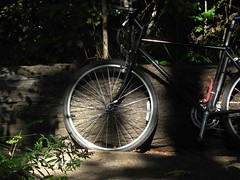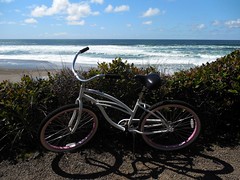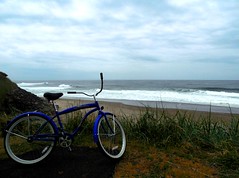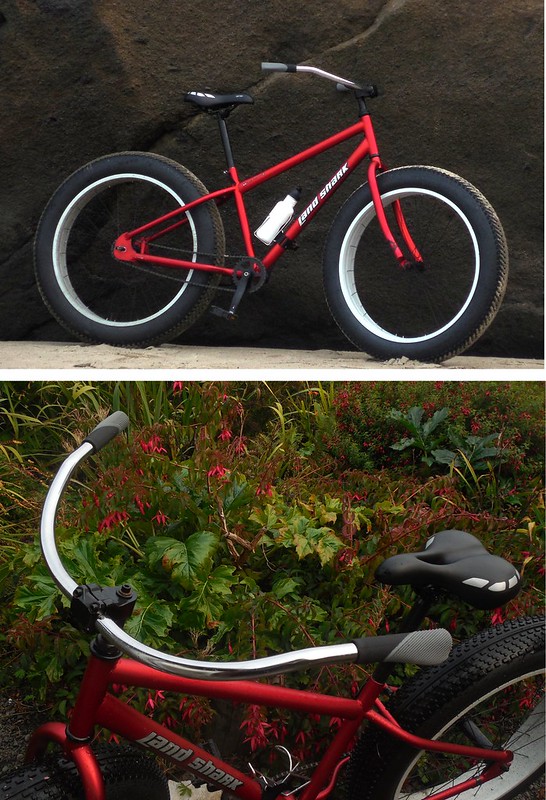 I’ve recently had some “fun” switching around our telecom service, mobile and home-based. I’ve also had some experience at the state DMV/DEQ, which offers and interesting contrast.
I’ve recently had some “fun” switching around our telecom service, mobile and home-based. I’ve also had some experience at the state DMV/DEQ, which offers and interesting contrast.
(Side note: I also recently switched to hosting our blogs in the cloud, and switched our business Internet service to consumer, since I am no longer hosting servers at home. But that’s a whole other story.)
The big, bad bureaucracy
First, let’s talk about how things work at the DMV. If you live in Oregon’s Portland metro area, you have to get your vehicle’s emissions systems checked by Oregon DEQ every two years in order to renew your registration. It’s pretty straight forward.
- DMV sends you a renewal notice
- You take this notice to one of several DEQ “Clean Air Stations” (this is funny, because it’s probably some of the dirtiest air around, what with all those vehicles idling while waiting and getting checked)
- An attendant will check that you have the correct paperwork, then direct you to a lane
- There is a large blue street sign on the building at each lane that clearly tells you how much you are paying for the emissions check: $21.
- Once in a test bay, the testing tech will ask you to leave your car running, and direct you to an enclosed room where you can fill in your insurance information while the tech hooks up your car to the computer.
- After a few minutes, you are finished, and you pay both the DEQ fee and your DMV renewal fee (in a single transaction), receive your DEQ report, new tags and registration, and head on your way.
I don’t know why people like to bitch about government bureaucracy; this most common interaction with not one but two massive state agencies takes all of 15 minutes every two years.
Anyway, let’s talk about telecoms.
You still have a land line?
Several years ago we switched our land line phone (remember those? We still have one!) from Qwest (now CenturyLink) to Vonage, a voice over IP (VoIP) provider. It seemed like a great deal; $15 a month with unlimited domestic long distance (this was at a time when Qwest still charged for long distance).But after a couple years I noticed the price had jacked up to $25. I remember trying to shave that down by a dollar a month by switching plans, only to find after making the switch that Vonage charged me $10 for changing plans. Pretty soon we were paying around $35 a month for service, after they tacked on close to $10 in various “taxes and fees.”
A coworker suggested checking out Ooma, another VoIP provider, which boasts “free” local service. The deal is you buy the box for $150 (Vonage gives you a box if you sign up for a 2-year contract), then just pay taxes and fees on a monthly basis. This is how I discovered that Vonage not only was overcharging for their basic service, they were also robbing us about six bucks a month on fees. We now pay $3.79 a month for our land line. Period. Quality of service? Same. There are a couple features we gave up from Vonage (emailed voice mail, etc.), but we can get those back for another $10 a month from Ooma if we want, and still save $20 over Vonage.
Shortly after the switch, Vonage had the chutzpah to send an email begging us to come back, offering a $10 discount per month for two years. Ha ha!
OK, so maybe the free market is working, right? Wrong. The deal is that it’s incredibly difficult to compare these two services, even though they are basically the same. Their pricing structures are so different, and the marketplace is so cluttered with unrelated technology that seems similar (but totally is not), it is virtually impossible for somebody like, say, your mother, to figure this shit out and not get robbed by some bastard company claiming your taxes and fees are $10 a month. Or the cable company that convinces you you need a land line to go with your TV and internet, because it’s somehow cheaper when you pay more.
Anyway, we got the land line sorted out, and even got to keep our number that we had originally ported from Qwest to Vonage. That’s how we’re still rocking that North Portland exchange out in the burbs.
Bite me, T-Mobile
So, how about mobile service?
Oh, let me tell you a tale, involving three service providers and one federal regulator who intervened on my behalf.
Way back when, my lovely wife declared she needed a cell phone. I scoffed. I resisted. But eventually I gave in. I searched high and low for the best deal, eventually settling on Qwest for a $30/month plan. This was a great deal. Until we went over on minutes, which was highway robbery. So we switched to Sprint. They had a flex pricing plan, which just bumped you to the next level if you went over minutes. This was pretty good. I eventually got a phone on that plan, too. In the end we had five phones on that plan, and we were paying about $160 a month for 700 shared minutes, unlimited text, and a 2G data plan on one feature phone. Too much, considering there was not a smartphone in the lot.
When my daughter and I got smartphones last year, we dropped two lines from Sprint, and found the best deal on a data plan around (or so it seemed). T-Mobile has a prepaid plan with unlimited text and data (speeds capped after the first 5GB of 4G/LTE) and 100 minutes of talk time for $30 a month.
A word about mobile prepaid: These plans are set up for people with bad credit, mainly. You pay for your service in advance, instead of after a month, as is traditional. There are no contracts, so if you have your own phone, it’s an easy short-term thing to do. We don’t have bad credit, but the post-paid plans did not have this kind of deal on data. So we signed up.
When you set up your prepaid account, you pay for your first month of service. You can also deposit some additional money on account to pay for any overages on talk time. And you can set up this account to deduct from your debit card on a monthly basis and pay for the next month of service. Pretty convenient, and what could go wrong? (Oh, just wait for it.)
Anyway, we had that service for about a year, and it worked fine except when it didn’t. (T-Mobile coverage is crap, in case you didn’t know.) I paid for a few extra minutes of talk time here and there, but nothing serious. We were getting more mobile data than we could use for two phones at $60 a month.
This year, the contracts on our three remaining Sprint lines expired, and we prepared to move everybody, in one fell swoop, to AT&T. I knew this wasn’t going to be a cakewalk, but as is my practice, I thoroughly researched everything and got all my ducks in a row before proceeding.
I bought a few unlocked phones, and took everything down to the AT&T store at the mall. This was on THE DAY that the iPhone 6 was released, so it was pretty funny to pass the hordes lined up at the Apple store on the way to the AT&T store (where they had about four linear feet of wall space dedicated to the lackluster new iPhones, opposite a dazzling display of LG phones and phablets).
We had to wait a little bit to get served. Once in, it was pretty straight forward, since I knew exactly what I wanted, and already owned the devices. It took a while, but we got all five numbers ported. Well, mostly. Major props to Allan at the Washington Square AT&T store, who was helpful all the way.
It turns out the T-Mobile numbers didn’t exactly port.
The next day, I called AT&T customer support. They said they needed the PINs for the T-Mobile accounts. I told them I never set up PINs for those accounts, and I had provided the passwords. The AT&T rep conferenced in a T-Mobile rep, who seemed a bit confused by what was going on. It took him a while, but after answering some security questions, he let me set the PIN to 1-2-3-4. Ten minutes later, the numbers were ported.
Whew! Now, I had the foresight to stop the monthly auto-deduct on the T-Mobile accounts. I left about $100 on account in case the port took longer than it did (numbers can’t be ported if the account isn’t active, and prepaid accounts are suspended immediately if not paid up). Now that the port was complete, I thought I’d log in to T-Mobile and see about getting that dough back.
But my accounts were gone. There was no way to log in from the Web.
I called customer service. This did not go well. First, after punching in one of my numbers, the automated system informed me that the account was in collections for nonpayment. I hit “0” and eventually got a live voice. I talked to a few people, got transferred several times, and after waiting on hold got a guy who told me that prepaid services are not refundable.
I patiently explained that I was not asking for a refund for a prepaid service, I was asking for the cash I had on account to be refunded. He again repeated that prepaid services are not refundable. I pressed him. Eventually he said, OK, you can get your money back, but you have to go to a T-Mobile store.
Are you fucking kidding me? “What do I need to show them to get my money?” I asked. “Just the card you used to pay,” he said.
OK, fine, sounds dubious, but I drove my ass to the nearest T-Mobile store. It’s a weekday, this can’t be too bad, I thought.
It was pretty bad. It was a small store, and all four staff members were busy with customers. I waited patiently for probably 20 minutes. Finally a staff member was available, and she proceeded to inform me that prepaid services are not refundable.
I patiently explained that I was not asking for a refund for prepaid services, but for the money I placed on account to pay for future prepaid services before I ported my numbers out.
“Oh, you ported your numbers out,” she said, and explained that prepaid services are not refundable, especially, apparently, if you port your numbers out. By this point I was getting pretty pissed off, and really didn’t want to make a scene. (Actually, I might have made a little bit of a scene, but I’m pretty sure I said “B.S.” and not “bullshit”, because there were children present after all.)
“So,” I said, “I have to file a complaint to get my money back?”
“OK,” she said, deflecting me out the front door. (I’ve done customer service, so I understand the difficulty of dealing with pissed off people. She handled me like a champ.)
By now I’d blown probably a couple hours trying to get $100 back. Time is money, but principle is principle. That’s what this was coming down to.
I spent some more time searching the Web, trying to figure out how to proceed. I found lots of stories of being transferred and dropped on the customer service line, with nobody reporting any luck. Surely this couldn’t be legal, even if I did “agree” to terms of service which may or may not have spelled out that any money I deposit with them for future service would be confiscated if I chose to discontinue their service.
All of my T-Mobile love had turned to hatred and rage at this point. Their Web site, which I tolerated before, now was a maddening maze. The only options for customer service are Web forums (no account; no access!) and phone, which I’d already struck out on. No email contact, or even a Web form to submit queries. Just a USPS address. I imagined carts of paper mail in a warehouse somewhere gathering dust, and a couple underpaid office drones tasked with opening a few letters each day and sending out form letter responses.
Feds to the rescue
So I filed an online complaint with the FCC. That’s right, Fuck ’em. I sicced the feds on their thieving asses. I honestly did not expect anything to come of this. I figured I’d just write the whole episode off as a hard-learned lesson, and maybe provide T-Mobile with $100 worth of negative publicity along the way.
Two weeks later, I got a call from a passably contrite T-Mobile rep saying they she had a letter from the FCC, and even though my terms of service said that prepaid services are not refundable, they were going to send me a refund and just needed my address.
Her tone was notably straight-forward. Even though T-Mobile was not going to acknowledge they were in the wrong, they were going to give me back my money. And they weren’t going to transfer me, drop my call, or send me to a retail store.
I resisted the urge to explain to her that I was not asking for a refund of prepaid services. After all, it appeared I had won. It took more than a few hours of my life, but I was successful in prying my money back from a company that had attempted to steal it from me under cover of a murky customer agreement and a prepaid system designed to prey on poor people.
A week after the call, I got a copy of the letter T-Mobile sent back to the feds, explaining to the Acting Chief of Consumer Inquiries and Complaints Division, Consumer and Governmental Affairs Bureau, Federal Communications Commission, that I had signed an agreement acknowledging that prepaid services are not refundable.
“Nevertheless,” the letter continued, “in an effort to amicably resolve this matter… T-Mobile agreed to refund $100.00” to me.
The day after that I got a prepaid MasterCard worth $100 in the mail, so I didn’t feel obligated to give T-Mobile $100 worth of bad publicity after all. (Oh, wait, too late.)
There you have it. Once again, the invisible hand of the free market works great! (But only with a slap from the very visible hand of federal regulators.)
We left Sprint, on the other hand, with a balance due, and they decided to threaten us with collections or disruption of service(!) if we didn’t pay up immediately. (Phone number portability is something telecoms are required to facilitate, but they really don’t seem to like it very much when they’re on the losing end of it). We were at least able to log in to the Sprint Web site to take care of their final bill.
So why didn’t I stay with Sprint? Their network isn’t compatible with our phones. Why didn’t I stick with T-Mobile? Their coverage sucks. (Also, ahem, it turns out they have some questionable business ethics.) Why didn’t I go with Verizon? They support some of our phones, but not others. Why don’t I just let the cell providers gouge me for “free” phones that actually cost $20+ a month? Because I don’t want my phone to be locked to one provider, and I sure as hell never want to sign up for a two-year contract with any telecom ever again.
It’s a damn jungle out there, that’s what it is. And the people getting screwed over the most are poor people on prepaid plans, and people who don’t have the tech savvy to compare plans from different providers and tease out costs of phones vs. costs of service, etc.
This is why I want telecoms to be like the DMV. I don’t want to spend hours doing cost analysis. I don’t want fancy mall stores with mood lighting and big graphics and solicitous sales clerks. I don’t want bullshit contracts and terms of service with hidden clauses. I don’t want to compare apples to oranges. And I sure as hell don’t want some unscrupulous behemoth of a telecom literally trying to steal my money.
I just want a drab facility in a run-down strip mall with a unionized workforce hooking me up with what I need, nothing more, nothing less.
I want a big blue sign on the wall that says: “Mobile Broadband: $30. Take a number. Please have forms filled out and documents ready.”
 I haven’t played in a band since 1997, but just recently started some long-distance collaboration with a bandmate from Totem Soul, the group I moved to Portland with back in 1989.
I haven’t played in a band since 1997, but just recently started some long-distance collaboration with a bandmate from Totem Soul, the group I moved to Portland with back in 1989.





















